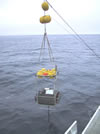
 |
| |
||||||||||||||||
|
Brown: Instruments everywhere |
| Science News | ||||
|
NOAA Ship Ron Brown - ROV Cruise 
ROPOS dive 629 involved extensive use of the elevator mooring to get equipment and samples down to the seafloor and back up again. Most of the elevator cargo was larval traps and settling arrays, which are both tools used to investigate how vent animals colonize new sites. Larval traps collect animal larvae that is floating by in the water, whereas the setting arrays collect larvae after they have settled out of the water, attach themselves to a substrate, and start to grow into juveniles. More... |
|
R/V Wecoma - CTD Cruise
|
| Teacher Logbooks | ||||
|
NOAA Ship Ron Brown - Jeff Goodrich 
Deploying and recovering instruments from the ocean floor is no easy task.
It takes many skilled people and a lot of ingenuity. The science party
brought along two PMEL engineers, Chris Meinig and Nick Delich, who perform
a multitude of tasks while on board and in the office (where they design
and test the instruments needed for research cruises). The engineers are
assisted by Bruce Cowden, the chief bosun, and the ROPOS crew while preparing
the instruments for deployment and recovery. Their biggest challenge thus
far was to overload an aluminum-rail elevator three times its maximum
load, deploy it, sink it, unload it, load it back up, release it from
the bottom, and recover it all during daylight hours. |
|
R/V Wecoma - Missy Holzer
|
|
Jeff G: Haven't you been going to sea for quite some time now? Susan: I've been out of school for ten years and over that time period I've been on close to 30 cruises. I've spent about two of the last ten years of my life at sea. Only about ten of those cruises were for research. The rest were with private industry where I was cruised all over the world doing side-scan sonar and bathymetry surveys, mainly to provide information needed to lay fiber-optic cables. One of the first times I went to sea we were offshore Guam looking at the shoreline and palm trees. I turned to one of the other data processors and said, "Oh my god, isn't this just so beautiful." He turned to me and said, "It's an island. All islands look the same from a boat." It kind of gets that way after a while. I'm a little tired from the four cruises this summer. We did the first survey in early June. I just want to go home and see my garden, sip wine with my good friend David and pet my cat, Big Handsome Boy. More... |
||
| NeMO Home |About NeMO | Expeditions | NeMO Net | Explore | Dive! | Education |